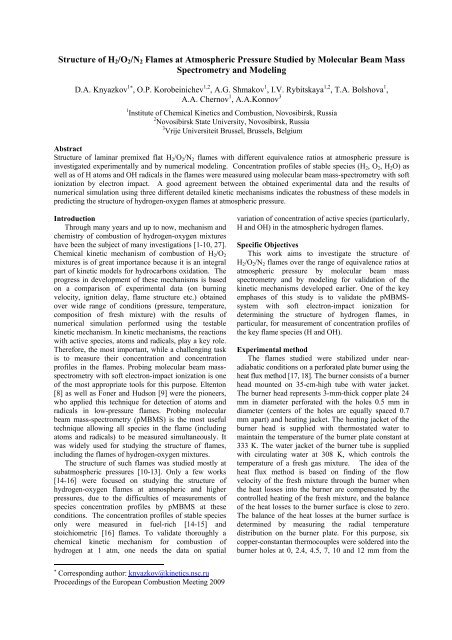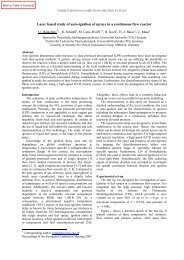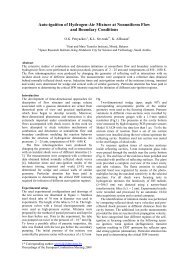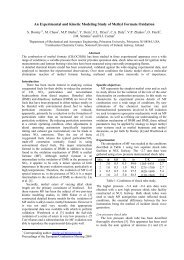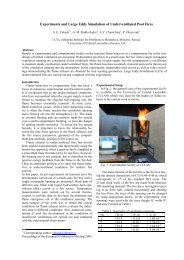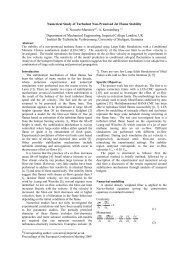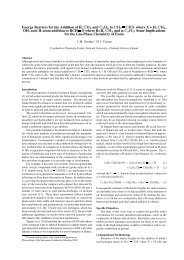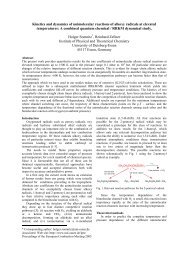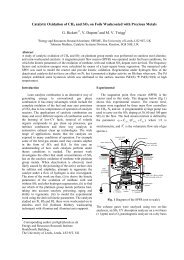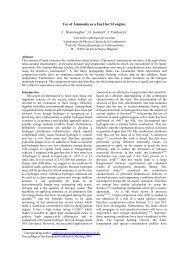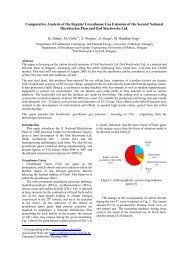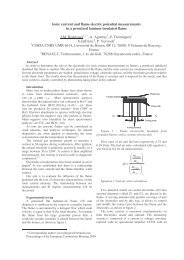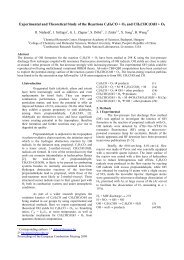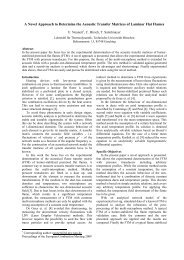Structure of H2/O2/N2 Flames at Atmospheric Pressure Studied by ...
Structure of H2/O2/N2 Flames at Atmospheric Pressure Studied by ...
Structure of H2/O2/N2 Flames at Atmospheric Pressure Studied by ...
Create successful ePaper yourself
Turn your PDF publications into a flip-book with our unique Google optimized e-Paper software.
<strong>Structure</strong> <strong>of</strong> <strong>H2</strong>/<strong>O2</strong>/<strong>N2</strong> <strong>Flames</strong> <strong>at</strong> <strong>Atmospheric</strong> <strong>Pressure</strong> <strong>Studied</strong> <strong>by</strong> Molecular Beam Mass<br />
Spectrometry and Modeling<br />
D.A. Knyazkov 1∗ , O.P. Korobeinichev 1,2 , A.G. Shmakov 1 , I.V. Rybitskaya 1,2 , T.A. Bolshova 1 ,<br />
A.A. Chernov 1 , A.A.Konnov 3<br />
1 Institute <strong>of</strong> Chemical Kinetics and Combustion, Novosibirsk, Russia<br />
2 Novosibirsk St<strong>at</strong>e University, Novosibirsk, Russia<br />
3 Vrije Universiteit Brussel, Brussels, Belgium<br />
Abstract<br />
<strong>Structure</strong> <strong>of</strong> laminar premixed fl<strong>at</strong> <strong>H2</strong>/<strong>O2</strong>/<strong>N2</strong> flames with different equivalence r<strong>at</strong>ios <strong>at</strong> <strong>at</strong>mospheric pressure is<br />
investig<strong>at</strong>ed experimentally and <strong>by</strong> numerical modeling. Concentr<strong>at</strong>ion pr<strong>of</strong>iles <strong>of</strong> stable species (<strong>H2</strong>, <strong>O2</strong>, <strong>H2</strong>O) as<br />
well as <strong>of</strong> H <strong>at</strong>oms and OH radicals in the flames were measured using molecular beam mass-spectrometry with s<strong>of</strong>t<br />
ioniz<strong>at</strong>ion <strong>by</strong> electron impact. A good agreement between the obtained experimental d<strong>at</strong>a and the results <strong>of</strong><br />
numerical simul<strong>at</strong>ion using three different detailed kinetic mechanisms indic<strong>at</strong>es the robustness <strong>of</strong> these models in<br />
predicting the structure <strong>of</strong> hydrogen-oxygen flames <strong>at</strong> <strong>at</strong>mospheric pressure.<br />
Introduction<br />
Through many years and up to now, mechanism and<br />
chemistry <strong>of</strong> combustion <strong>of</strong> hydrogen-oxygen mixtures<br />
have been the subject <strong>of</strong> many investig<strong>at</strong>ions [1-10, 27].<br />
Chemical kinetic mechanism <strong>of</strong> combustion <strong>of</strong> <strong>H2</strong>/<strong>O2</strong><br />
mixtures is <strong>of</strong> gre<strong>at</strong> importance because it is an integral<br />
part <strong>of</strong> kinetic models for hydrocarbons oxid<strong>at</strong>ion. The<br />
progress in development <strong>of</strong> these mechanisms is based<br />
on a comparison <strong>of</strong> experimental d<strong>at</strong>a (on burning<br />
velocity, ignition delay, flame structure etc.) obtained<br />
over wide range <strong>of</strong> conditions (pressure, temper<strong>at</strong>ure,<br />
composition <strong>of</strong> fresh mixture) with the results <strong>of</strong><br />
numerical simul<strong>at</strong>ion performed using the testable<br />
kinetic mechanism. In kinetic mechanisms, the reactions<br />
with active species, <strong>at</strong>oms and radicals, play a key role.<br />
Therefore, the most important, while a challenging task<br />
is to measure their concentr<strong>at</strong>ion and concentr<strong>at</strong>ion<br />
pr<strong>of</strong>iles in the flames. Probing molecular beam massspectrometry<br />
with s<strong>of</strong>t electron-impact ioniz<strong>at</strong>ion is one<br />
<strong>of</strong> the most appropri<strong>at</strong>e tools for this purpose. Eltenton<br />
[8] as well as Foner and Hudson [9] were the pioneers,<br />
who applied this technique for detection <strong>of</strong> <strong>at</strong>oms and<br />
radicals in low-pressure flames. Probing molecular<br />
beam mass-spectrometry (pMBMS) is the most useful<br />
technique allowing all species in the flame (including<br />
<strong>at</strong>oms and radicals) to be measured simultaneously. It<br />
was widely used for studying the structure <strong>of</strong> flames,<br />
including the flames <strong>of</strong> hydrogen-oxygen mixtures.<br />
The structure <strong>of</strong> such flames was studied mostly <strong>at</strong><br />
sub<strong>at</strong>mospheric pressures [10-13]. Only a few works<br />
[14-16] were focused on studying the structure <strong>of</strong><br />
hydrogen-oxygen flames <strong>at</strong> <strong>at</strong>mospheric and higher<br />
pressures, due to the difficulties <strong>of</strong> measurements <strong>of</strong><br />
species concentr<strong>at</strong>ion pr<strong>of</strong>iles <strong>by</strong> pMBMS <strong>at</strong> these<br />
conditions. The concentr<strong>at</strong>ion pr<strong>of</strong>iles <strong>of</strong> stable species<br />
only were measured in fuel-rich [14-15] and<br />
stoichiometric [16] flames. To valid<strong>at</strong>e thoroughly a<br />
chemical kinetic mechanism for combustion <strong>of</strong><br />
hydrogen <strong>at</strong> 1 <strong>at</strong>m, one needs the d<strong>at</strong>a on sp<strong>at</strong>ial<br />
∗ Corresponding author: knyazkov@kinetics.nsc.ru<br />
Proceedings <strong>of</strong> the European Combustion Meeting 2009<br />
vari<strong>at</strong>ion <strong>of</strong> concentr<strong>at</strong>ion <strong>of</strong> active species (particularly,<br />
H and OH) in the <strong>at</strong>mospheric hydrogen flames.<br />
Specific Objectives<br />
This work aims to investig<strong>at</strong>e the structure <strong>of</strong><br />
<strong>H2</strong>/<strong>O2</strong>/<strong>N2</strong> flames over the range <strong>of</strong> equivalence r<strong>at</strong>ios <strong>at</strong><br />
<strong>at</strong>mospheric pressure <strong>by</strong> molecular beam mass<br />
spectrometry and <strong>by</strong> modeling for valid<strong>at</strong>ion <strong>of</strong> the<br />
kinetic mechanisms developed earlier. One <strong>of</strong> the key<br />
emphases <strong>of</strong> this study is to valid<strong>at</strong>e the pMBMSsystem<br />
with s<strong>of</strong>t electron-impact ioniz<strong>at</strong>ion for<br />
determining the structure <strong>of</strong> hydrogen flames, in<br />
particular, for measurement <strong>of</strong> concentr<strong>at</strong>ion pr<strong>of</strong>iles <strong>of</strong><br />
the key flame species (H and OH).<br />
Experimental method<br />
The flames studied were stabilized under nearadiab<strong>at</strong>ic<br />
conditions on a perfor<strong>at</strong>ed pl<strong>at</strong>e burner using the<br />
he<strong>at</strong> flux method [17, 18]. The burner consists <strong>of</strong> a burner<br />
head mounted on 35-cm-high tube with w<strong>at</strong>er jacket.<br />
The burner head represents 3-mm-thick copper pl<strong>at</strong>e 24<br />
mm in diameter perfor<strong>at</strong>ed with the holes 0.5 mm in<br />
diameter (centers <strong>of</strong> the holes are equally spaced 0.7<br />
mm apart) and he<strong>at</strong>ing jacket. The he<strong>at</strong>ing jacket <strong>of</strong> the<br />
burner head is supplied with thermost<strong>at</strong>ed w<strong>at</strong>er to<br />
maintain the temper<strong>at</strong>ure <strong>of</strong> the burner pl<strong>at</strong>e constant <strong>at</strong><br />
333 K. The w<strong>at</strong>er jacket <strong>of</strong> the burner tube is supplied<br />
with circul<strong>at</strong>ing w<strong>at</strong>er <strong>at</strong> 308 K, which controls the<br />
temper<strong>at</strong>ure <strong>of</strong> a fresh gas mixture. The idea <strong>of</strong> the<br />
he<strong>at</strong> flux method is based on finding <strong>of</strong> the flow<br />
velocity <strong>of</strong> the fresh mixture through the burner when<br />
the he<strong>at</strong> losses into the burner are compens<strong>at</strong>ed <strong>by</strong> the<br />
controlled he<strong>at</strong>ing <strong>of</strong> the fresh mixture, and the balance<br />
<strong>of</strong> the he<strong>at</strong> losses to the burner surface is close to zero.<br />
The balance <strong>of</strong> the he<strong>at</strong> losses <strong>at</strong> the burner surface is<br />
determined <strong>by</strong> measuring the radial temper<strong>at</strong>ure<br />
distribution on the burner pl<strong>at</strong>e. For this purpose, six<br />
copper-constantan thermocouples were soldered into the<br />
burner holes <strong>at</strong> 0, 2.4, 4.5, 7, 10 and 12 mm from the
Table 1. Summary <strong>of</strong> different parameters for the flames studied.<br />
Flame<br />
Rich flame Near-stoichiometric<br />
flame<br />
Lean flame Calibr<strong>at</strong>ion flame<br />
Equivalence r<strong>at</strong>io<br />
2 1.1 0.47 1.1<br />
φ=([<strong>H2</strong>]/[<strong>O2</strong>])/([<strong>H2</strong>]/[<strong>O2</strong>])stoichiometry<br />
Dilution r<strong>at</strong>io D=[<strong>O2</strong>]/([<strong>O2</strong>]+[<strong>N2</strong>]) 0.077 0.09 0.209 0.14<br />
Flow velocity <strong>of</strong> fresh mixture <strong>at</strong> burner<br />
surface (in the experiments), cm/s<br />
40.7 42.5 34.24 49.1<br />
Measured burning velocity <strong>of</strong> free<br />
propag<strong>at</strong>ing flame, cm/s<br />
41.1 47 55<br />
Burning velocity <strong>of</strong> free propag<strong>at</strong>ing flame<br />
calcul<strong>at</strong>ed using kinetic mechanism [2], cm/s<br />
39.6 38.3 36.2 141.6<br />
center <strong>of</strong> the burner. The flow velocity <strong>of</strong> the fresh<br />
mixture where<strong>by</strong> the above conditions are s<strong>at</strong>isfied is<br />
adiab<strong>at</strong>ic burning velocity <strong>by</strong> definition.<br />
Compositions and flow r<strong>at</strong>es <strong>of</strong> the fresh mixtures<br />
studied were set <strong>by</strong> mass flow controllers (MKS<br />
Instruments Inc.). The st<strong>at</strong>ed purity <strong>of</strong> gases (<strong>H2</strong>, <strong>O2</strong>, <strong>N2</strong>)<br />
was 99.95%. Three flames <strong>of</strong> different compositions<br />
were studied in this work and a flame called “calibr<strong>at</strong>ion<br />
flame” was used to calibr<strong>at</strong>e the MBMS-setup for<br />
measurements <strong>of</strong> absolute concentr<strong>at</strong>ions <strong>of</strong> H and OH<br />
radicals. Table 1 shows the compositions, equivalence<br />
and dilution r<strong>at</strong>ios for all four flames. Linear velocities<br />
<strong>of</strong> the fresh mixtures <strong>at</strong> the burner surface as well as<br />
measured and calcul<strong>at</strong>ed (using PREMIX code [19-21]<br />
and chemical kinetic mechanism [2]) burning velocities<br />
<strong>of</strong> these flames are also given in the Table 1. To<br />
stabilize reliably the flames during the flame structure<br />
measurements, the flow velocities <strong>of</strong> the fresh mixtures<br />
were set somewh<strong>at</strong> below the burning velocities <strong>of</strong> these<br />
mixtures. The lean flame (φ=0.47) had a cellular<br />
structure when the flow <strong>of</strong> the fresh gas mixture is close<br />
to the burning velocity. Thus, to elimin<strong>at</strong>e this effect,<br />
the flame was stabilized with the fresh mixture flow<br />
40% lower than the burning velocity <strong>of</strong> the flame in this<br />
mixture. Temper<strong>at</strong>ure pr<strong>of</strong>iles in the flames were<br />
measured using Pt/Pt+10%Rh thermocouple made <strong>of</strong><br />
wires 0.02 mm in diameter and co<strong>at</strong>ed with Si<strong>O2</strong> (total<br />
diameter <strong>of</strong> the co<strong>at</strong>ed thermocouple was ~0.04 mm).<br />
Concentr<strong>at</strong>ion pr<strong>of</strong>iles <strong>of</strong> the species were obtained<br />
using molecular beam sampling system coupled with<br />
quadrupole mass-spectrometer MS-7302 with s<strong>of</strong>t<br />
ioniz<strong>at</strong>ion <strong>by</strong> electron impact [22]. Sampling was<br />
performed <strong>at</strong> different heights above the burner surface<br />
using a quartz “sonic” probe. The opening angle <strong>of</strong> the<br />
probe was 40 ○ , the orifice diameter was 0.08 mm, and<br />
the wall thickness near the orifice was 0.08 mm.<br />
A sampling probe is known to perturb a flame<br />
structure. The total probe effect on the flame is a<br />
combin<strong>at</strong>ion <strong>of</strong> thermal and gas-dynamic perturb<strong>at</strong>ions<br />
<strong>of</strong> the flame. To take into account the thermal<br />
perturb<strong>at</strong>ions, temper<strong>at</strong>ure pr<strong>of</strong>iles measured in the<br />
flame <strong>by</strong> a thin thermocouple <strong>at</strong> a certain distance<br />
“probe tip - thermocouple” in front <strong>of</strong> the probe tip are<br />
usually used in the calcul<strong>at</strong>ions <strong>of</strong> concentr<strong>at</strong>ion pr<strong>of</strong>iles<br />
<strong>of</strong> flame species. In our experiments, the distance<br />
“probe tip – thermocouple junction” was chosen to be<br />
0.2 mm. To valid<strong>at</strong>e this choice we have preliminary<br />
measured temper<strong>at</strong>ure pr<strong>of</strong>iles in the nearstoichiometric<br />
flame with the thermocouple positioned<br />
2<br />
<strong>at</strong> different distances from the probe tip (0.1, 0.2, 0.3<br />
and 0.4 mm). The obtained results are shown in Fig. 1.<br />
Using these pr<strong>of</strong>iles and the detailed chemical kinetic<br />
mechanism [23] we simul<strong>at</strong>ed the flame structure. A<br />
criterion for choosing the most appropri<strong>at</strong>e distance<br />
“probe tip – thermocouple junction” was as following:<br />
position <strong>of</strong> H and OH maximums on corresponding<br />
measured concentr<strong>at</strong>ion pr<strong>of</strong>iles should be in agreement<br />
with those on calcul<strong>at</strong>ed pr<strong>of</strong>iles obtained using the<br />
appropri<strong>at</strong>ely measured temper<strong>at</strong>ure pr<strong>of</strong>ile. We find<br />
this criterion to be justified, because in this case the<br />
accuracy <strong>of</strong> absolute concentr<strong>at</strong>ion <strong>of</strong> the species does<br />
not need to be perfect. In addition, position <strong>of</strong> the<br />
maximum on the measured H and/or OH concentr<strong>at</strong>ion<br />
pr<strong>of</strong>ile is far easier to recognize and to compare with the<br />
numerical results. Figure 2 shows H and OH<br />
concentr<strong>at</strong>ion pr<strong>of</strong>iles measured in the nearstoichiometric<br />
flame as well as calcul<strong>at</strong>ed ones using the<br />
temper<strong>at</strong>ure pr<strong>of</strong>iles given in Fig. 1 (the calcul<strong>at</strong>ions<br />
were performed using PREMIX code [19-21] and<br />
chemical kinetic mechanism [23]). Comparing the<br />
experimental and modeling results shown in Fig. 2 one<br />
can conclude th<strong>at</strong> for the near-stoichiometric flame the<br />
appropri<strong>at</strong>e distance “probe tip – thermocouple<br />
junction” is somewhere between 0.15 and 0.2 mm.<br />
Since the conditions (post-flame temper<strong>at</strong>ure, velocity<br />
<strong>of</strong> the flow riding on the probe) for lean (φ=0.47) and<br />
rich (φ=2.0) <strong>H2</strong>/<strong>O2</strong>/<strong>N2</strong> flames studied are very similar to<br />
those for the near-stoichiometric flame (φ=1.1), the<br />
Temper<strong>at</strong>ure, K<br />
1600<br />
1400<br />
1200<br />
1000<br />
800<br />
600<br />
0.4 mm<br />
0.3 mm<br />
0.2 mm<br />
0.1 mm<br />
400<br />
0.0 0.5 1.0 1.5 2.0<br />
Distance from burner surface, mm<br />
Fig. 1. Temper<strong>at</strong>ure pr<strong>of</strong>iles measured in presence <strong>of</strong><br />
the sampling probe <strong>by</strong> the thermocouple positioned<br />
<strong>at</strong> different distances “probe tip – thermocouple<br />
junction” in near-stoichiometric <strong>H2</strong>/<strong>O2</strong>/<strong>N2</strong> flame<br />
(φ=1.1, D=0.09).
Mole fraction <strong>of</strong> H<br />
0.010<br />
0.008<br />
0.006<br />
0.004<br />
0.002<br />
measured H pr<strong>of</strong>ile<br />
0.1 mm<br />
0.2 mm<br />
0.3 mm<br />
0.4 mm<br />
0.000<br />
0 1 2 3 4 5<br />
Distance from burner surfce, mm<br />
Mole fraction <strong>of</strong> OH<br />
3<br />
0.0020<br />
0.0015<br />
0.0010<br />
0.0005<br />
measured OH pr<strong>of</strong>ile<br />
0.0000<br />
0 1 2 3 4 5<br />
Distance from burner surface, mm<br />
appropri<strong>at</strong>e position <strong>of</strong> the thermocouple rel<strong>at</strong>ive to<br />
probe tip can be assumed to be the same.<br />
To take into account the gas-dynamic perturb<strong>at</strong>ion <strong>of</strong><br />
the flames <strong>by</strong> the sampling probe, the upstream shift ∆Z<br />
<strong>of</strong> all measured concentr<strong>at</strong>ion pr<strong>of</strong>iles was made. The<br />
value <strong>of</strong> ∆Z was estim<strong>at</strong>ed using the following<br />
semiempirical formula proposed earlier [24]:<br />
Q<br />
∆Z = 0 . 37 ⋅ d ⋅ ,<br />
S ⋅V<br />
where d is the probe orifice diameter, Q is gas flow r<strong>at</strong>e<br />
through the probe orifice, S denotes probe orifice area,<br />
V is the velocity <strong>of</strong> incoming gas flow.<br />
The absolute concentr<strong>at</strong>ions <strong>of</strong> the measured species<br />
were determined using the corresponding calibr<strong>at</strong>ion<br />
coefficients. These coefficients for <strong>H2</strong>, <strong>O2</strong> and <strong>H2</strong>O<br />
were obtained <strong>by</strong> direct calibr<strong>at</strong>ion. For this purpose, the<br />
measurements <strong>of</strong> the intensities <strong>of</strong> the base mass peaks<br />
(m/z) 2, 32 and 18 in the gas mixture <strong>of</strong> known<br />
composition consisting <strong>of</strong> air and hydrogen and<br />
containing the w<strong>at</strong>er vapor he<strong>at</strong>ed to the temper<strong>at</strong>ure <strong>of</strong><br />
200 ○ Fig. 2. Concentr<strong>at</strong>ion pr<strong>of</strong>iles <strong>of</strong> H and OH radicals. Symbols: measurements; lines: modeling (using kinetic<br />
mechanism [23]) with temper<strong>at</strong>ure pr<strong>of</strong>iles measured <strong>at</strong> different distances “probe tip - thermocouple”.<br />
C were performed. Peak intensity <strong>of</strong> argon<br />
presenting in the air was used as a reference. The<br />
calibr<strong>at</strong>ion coefficient ki rel<strong>at</strong>ing to argon was evalu<strong>at</strong>ed<br />
using the following formula:<br />
ki = Ci×I40/CAr×Ii, (1)<br />
where Ii and I40 are the intensities <strong>of</strong> the base peak for ispecies<br />
and for argon, respectively; Сi and СAr are mole<br />
Mole fraction<br />
0,30<br />
0,25<br />
0,20<br />
0,15<br />
0,10<br />
0,05<br />
0,00<br />
T T<br />
<strong>H2</strong><br />
H<br />
<strong>H2</strong>O<br />
<strong>O2</strong><br />
0 1 2 3 4<br />
Height above burner, mm<br />
1800<br />
1600<br />
1400<br />
1200<br />
1000<br />
800<br />
600<br />
400<br />
200<br />
0<br />
Temper<strong>at</strong>ure, K<br />
Fig. 3. Temper<strong>at</strong>ure pr<strong>of</strong>ile and concentr<strong>at</strong>ion pr<strong>of</strong>iles<br />
<strong>of</strong> stabile species in calibr<strong>at</strong>ion flame <strong>H2</strong>/<strong>O2</strong>/<strong>N2</strong> flame<br />
(φ=1.1, D=0.14). Symbols are experimental d<strong>at</strong>a; lines<br />
are modeling using kinetic mechanism [23].<br />
fractions <strong>of</strong> the species being calibr<strong>at</strong>ed and argon,<br />
respectively.<br />
The measurements <strong>of</strong> H <strong>at</strong>oms and OH radicals in<br />
the flames were carried out with the energy <strong>of</strong> ionizing<br />
electrons <strong>of</strong> 16.2 eV, which allowed the contribution<br />
from other species to the corresponding mass spectra to<br />
be excluded. Calibr<strong>at</strong>ion <strong>of</strong> H and OH radicals was<br />
performed using a well known method proposed earlier<br />
[25]. We have already employed it for sub<strong>at</strong>mospheric<br />
hydrogen-oxygen flames [26]. This method is based on<br />
a fact th<strong>at</strong> in the post-flame zone <strong>of</strong> hydrogen flames<br />
partial equilibrium <strong>of</strong> three “fast” reactions takes place.<br />
These three reactions are the following:<br />
Н2 + ОН =Н2О + Н (I)<br />
Н2 + О = Н + ОН (II)<br />
О2 + Н = ОН + О (III)<br />
The equilibrium constants K1, K2 and K3 [23]<br />
corresponding to the aforementioned reactions are given<br />
below:<br />
К1=0.113×Т 0.0839 ×е 7680/Т (2)<br />
К2 = 1.8×Т 0.027 ×е -917/Т (3)<br />
К3=302×Т -0.374 ×е -8620/Т (4)<br />
The expressions for H, O and OH in this<br />
approxim<strong>at</strong>ion are <strong>of</strong> the following form:<br />
[OH] = K 2 × K 3 × [ <strong>O2</strong><br />
] × [ H 2 ] , (5)<br />
[O] = K 1 × K3<br />
× [ H 2]<br />
× [ <strong>O2</strong>]<br />
, (6)<br />
[ H 2O]<br />
[H] = K1[<br />
H 2 ]<br />
K 2 × K 3 × [ <strong>O2</strong><br />
] × [ H 2 ] . (7)<br />
[ H 2O]<br />
In the post flame zone (1.5-4 mm above the burner)<br />
<strong>of</strong> all hydrogen flames with φ=0.47, 1.1 and 2.0<br />
(D=0.209, 0.09 and 0.077, respectively) studied in this<br />
work, the concentr<strong>at</strong>ions <strong>of</strong> H and OH calcul<strong>at</strong>ed <strong>by</strong><br />
both methods using PREMIX and the detailed kinetic<br />
mechanism [23] and using the above formulas differ.<br />
This is because <strong>of</strong> rel<strong>at</strong>ively low post-flame temper<strong>at</strong>ure<br />
(1200-1350 К). For this reason, to carry out the<br />
calibr<strong>at</strong>ion <strong>of</strong> radicals we used hotter flame (calibr<strong>at</strong>ion<br />
flame) with the post-flame temper<strong>at</strong>ure <strong>of</strong> 1600 K (see<br />
Table 1). To determine the calibr<strong>at</strong>ion coefficients for<br />
H and OH radicals and hence to obtain their absolute<br />
concentr<strong>at</strong>ion, concentr<strong>at</strong>ion pr<strong>of</strong>iles <strong>of</strong> <strong>H2</strong>, <strong>O2</strong> and <strong>H2</strong>O,<br />
as well as temper<strong>at</strong>ure pr<strong>of</strong>ile were measured. They are<br />
shown in Fig. 3. In this figure, the measured pr<strong>of</strong>iles are
Mole fraction<br />
0,012<br />
0,010<br />
0,008<br />
0,006<br />
0,004<br />
0,002<br />
0,000<br />
OH<br />
H<br />
0 1 2 3 4 5<br />
Height above burner, mm<br />
Fig. 4. Concentr<strong>at</strong>ion pr<strong>of</strong>iles <strong>of</strong> radicals in calibr<strong>at</strong>ion<br />
flame <strong>H2</strong>/<strong>O2</strong>/<strong>N2</strong> flame (φ=1.1, D=0.14). Symbols are<br />
experimental d<strong>at</strong>a; solid lines are modeling with the<br />
detailed chemical kinetic mechanism [23]; dashed lines<br />
are calcul<strong>at</strong>ion using the approach <strong>of</strong> partial equilibrium<br />
on three “fast” reactions.<br />
compared with those calcul<strong>at</strong>ed using kinetic<br />
mechanism [23].<br />
Inserting the values <strong>of</strong> concentr<strong>at</strong>ions <strong>of</strong> stable<br />
species and equilibrium constants into the formulas (5)<br />
and (7), the concentr<strong>at</strong>ions <strong>of</strong> H and OH in the postflame<br />
zone (<strong>at</strong> 1.2-1.5 mm) <strong>of</strong> the calibr<strong>at</strong>ion flame (φ=<br />
1.1, D = 0.14) above the burner were evalu<strong>at</strong>ed. The<br />
concentr<strong>at</strong>ion pr<strong>of</strong>iles <strong>of</strong> H and OH calcul<strong>at</strong>ed using the<br />
detailed kinetic mechanism [23] (and measured<br />
temper<strong>at</strong>ure pr<strong>of</strong>ile with the distance “probe tip –<br />
thermocouple junction” <strong>of</strong> 0.2 mm) and using the<br />
approach <strong>of</strong> partial equilibrium on three fast reactions<br />
are compared in Fig. 4. A good agreement clearly<br />
observed between them demonstr<strong>at</strong>es a correctness <strong>of</strong><br />
selection <strong>of</strong> the experimental conditions for calibr<strong>at</strong>ion<br />
<strong>of</strong> the MBMS-system. Thus, using the d<strong>at</strong>a obtained in<br />
the “hot” calibr<strong>at</strong>ion flame, the calibr<strong>at</strong>ion coefficients<br />
for H and OH were determined. These coefficients were<br />
used in the following for quantific<strong>at</strong>ion <strong>of</strong> absolute<br />
concentr<strong>at</strong>ions <strong>of</strong> H and OH in all flames studied (lean,<br />
near-stoichiometric and rich). Due to a very low<br />
concentr<strong>at</strong>ion <strong>of</strong> <strong>at</strong>omic oxygen in the post-flame zone,<br />
calibr<strong>at</strong>ion coefficient for it was not determined with<br />
adequ<strong>at</strong>e accuracy, so we do not provide in the<br />
following measured concentr<strong>at</strong>ion pr<strong>of</strong>iles <strong>of</strong> O radicals.<br />
Rel<strong>at</strong>ive error in determining the concentr<strong>at</strong>ions <strong>of</strong> the<br />
species from the measured mass peak intensities <strong>of</strong> H<br />
and OH radicals was within the range 40 - 60 %.<br />
Modeling<br />
Flame structure and burning velocity were simul<strong>at</strong>ed<br />
using PREMIX and CHEMKIN-II codes [19-21] taking<br />
into consider<strong>at</strong>ion thermodynamic and transport<br />
properties <strong>of</strong> all species, as well as a detailed chemical<br />
kinetic mechanism.<br />
Three different reaction mechanisms for hydrogen<br />
oxid<strong>at</strong>ion proposed earlier <strong>by</strong> Li et al. [1], O’Conaire et<br />
al. [2] and Konnov [23] were used for the modeling.<br />
4<br />
0.18<br />
0.16<br />
<strong>H2</strong>O 1600<br />
1400<br />
0.14<br />
0.12<br />
T<br />
1200<br />
0.10<br />
1000<br />
0.08<br />
0.06<br />
0.04<br />
<strong>H2</strong> <strong>O2</strong> 800<br />
600<br />
0.02<br />
400<br />
0.00<br />
200<br />
0 1 2 3 4 5<br />
Height above burner, mm<br />
Fig. 5. Temper<strong>at</strong>ure pr<strong>of</strong>iles and concentr<strong>at</strong>ion<br />
pr<strong>of</strong>iles <strong>of</strong> stable species in near-stoichiometric<br />
<strong>H2</strong>/<strong>O2</strong>/<strong>N2</strong> flame (φ=1.1 D=0.09). Symbols are<br />
experimental d<strong>at</strong>a; lines are modeling using the<br />
kinetic mechanism [23].<br />
Mole fraction<br />
Mole fraction<br />
Mole fraction<br />
0.25<br />
0.20<br />
0.15<br />
0.10<br />
0.05<br />
0.00<br />
<strong>H2</strong><br />
T<br />
<strong>O2</strong><br />
<strong>H2</strong>O<br />
0 1 2 3 4 5<br />
Height above burner, mm<br />
0.25<br />
1400<br />
T<br />
0.20 <strong>H2</strong> 1200<br />
0.15<br />
1000<br />
800<br />
0.10<br />
0.05<br />
<strong>H2</strong>O<br />
<strong>O2</strong> 600<br />
400<br />
0.00<br />
200<br />
0 1 2 3 4 5<br />
Height above burner, mm<br />
1600<br />
1400<br />
1200<br />
1000<br />
800<br />
600<br />
400<br />
200<br />
Fig. 7. Temper<strong>at</strong>ure pr<strong>of</strong>iles and concentr<strong>at</strong>ion<br />
pr<strong>of</strong>iles <strong>of</strong> stable species in rich <strong>H2</strong>/<strong>O2</strong>/<strong>N2</strong> flame<br />
(φ=2.0, D=0.077). Symbols are experimental d<strong>at</strong>a;<br />
lines are modeling using the kinetic mechanism [23].<br />
Multi-component diffusion and thermal diffusion<br />
options were taken into account. Adaptive mesh<br />
parameters were GRAD = 0.1 and CURV = 0.5.<br />
Results and Discussion<br />
Figures 5, 6 and 7 show measured concentr<strong>at</strong>ion<br />
pr<strong>of</strong>iles <strong>of</strong> stable species (<strong>H2</strong>O, <strong>H2</strong>, <strong>O2</strong>) in the nearstoichiometric,<br />
lean and rich flames, respectively. The<br />
pr<strong>of</strong>iles simul<strong>at</strong>ed using the kinetic mechanism [23] are<br />
also given in these figures. The species concentr<strong>at</strong>ion<br />
and temper<strong>at</strong>ure pr<strong>of</strong>iles predicted <strong>by</strong> the mechanisms<br />
Temper<strong>at</strong>ure, K<br />
Temper<strong>at</strong>ure, K<br />
Temper<strong>at</strong>ure, K<br />
Fig. 6. Temper<strong>at</strong>ure pr<strong>of</strong>iles and concentr<strong>at</strong>ion<br />
pr<strong>of</strong>iles <strong>of</strong> stable species in lean <strong>H2</strong>/<strong>O2</strong>/<strong>N2</strong> flame<br />
(φ=0.47, D=0.209). Symbols are experimental d<strong>at</strong>a;<br />
lines are modeling using the kinetic mechanism [23].
<strong>of</strong> Li et al. [1] and <strong>of</strong> O’Conaire et al. [2] are very close<br />
to those predicted <strong>by</strong> Konnov’s mechanism [23]. They<br />
are not shown in Figs. 5-7 to not overcharge them. A<br />
comparison <strong>of</strong> the measured concentr<strong>at</strong>ion pr<strong>of</strong>iles <strong>of</strong><br />
stable species with the simul<strong>at</strong>ed ones (Figs. 5-7) shows<br />
OH mole fraction<br />
0.0035<br />
0.0030<br />
0.0025<br />
0.0020<br />
0.0015<br />
0.0010<br />
0.0005<br />
experiment<br />
mech. <strong>of</strong> Li et al. [1]<br />
mech. <strong>of</strong> O'Conaire et al. [2]<br />
mech. <strong>of</strong> Konnov [23]<br />
0.0000<br />
0 1 2 3 4 5<br />
Height above burner, mm<br />
Fig. 8. OH concentr<strong>at</strong>ion pr<strong>of</strong>iles in lean <strong>H2</strong>/<strong>O2</strong>/<strong>N2</strong><br />
flame (φ=0.47, D=0.209). Symbols are<br />
experimental d<strong>at</strong>a; lines are modeling.<br />
0.008<br />
Mole fraction<br />
0.006<br />
0.004<br />
0.002<br />
OH<br />
H<br />
mech. <strong>of</strong> Li et al. [1]<br />
mech. <strong>of</strong> O'Conaire et al. [2]<br />
mech. <strong>of</strong> Konnov [23]<br />
0.000<br />
0 1 2 3 4 5<br />
Height above burner, mm<br />
Fig. 9. H and OH concentr<strong>at</strong>ion pr<strong>of</strong>iles in nearstoichiometric<br />
<strong>H2</strong>/<strong>O2</strong>/<strong>N2</strong> flame (φ=1.1, D=0.09).<br />
Symbols are experimental d<strong>at</strong>a; lines are<br />
modeling.<br />
H mole fraction<br />
0.008<br />
0.006<br />
0.004<br />
0.002<br />
experiment<br />
mech. <strong>of</strong> Li et al. [1]<br />
mech. <strong>of</strong> O'Conaire et al. [2]<br />
mech. <strong>of</strong> Konnov [23]<br />
0.000<br />
0 1 2 3 4 5<br />
Distance above burner, mm<br />
Fig. 10. H concentr<strong>at</strong>ion pr<strong>of</strong>iles in rich <strong>H2</strong>/<strong>O2</strong>/<strong>N2</strong><br />
flame (φ=2.0, D=0.077). Symbols are experimental<br />
d<strong>at</strong>a; lines are modeling.<br />
5<br />
th<strong>at</strong> the models used provide a good fit <strong>of</strong> the<br />
experimental d<strong>at</strong>a. Some small discrepancies observed<br />
between the measured and simul<strong>at</strong>ed concentr<strong>at</strong>ions <strong>of</strong><br />
<strong>H2</strong>O near the burner surface are associ<strong>at</strong>ed with<br />
vari<strong>at</strong>ion <strong>of</strong> the <strong>H2</strong>O calibr<strong>at</strong>ion coefficient depending<br />
on flame temper<strong>at</strong>ure. This is due to form<strong>at</strong>ion <strong>of</strong> <strong>H2</strong>O<br />
clusters in molecular beam while sampling from the<br />
low-temper<strong>at</strong>ure zone <strong>of</strong> the flame. Therefore, an<br />
excessive concentr<strong>at</strong>ion <strong>of</strong> <strong>H2</strong>O measured near the<br />
burner surface is rel<strong>at</strong>ed to the experimental errors.<br />
The concentr<strong>at</strong>ion pr<strong>of</strong>iles <strong>of</strong> H and OH radicals<br />
measured in the lean, near-stoichiometric and rich<br />
flames are given in Figs. 8, 9 and 10, respectively. The<br />
results <strong>of</strong> numerical calcul<strong>at</strong>ions using three kinetic<br />
mechanisms [1, 2, 23] are also plotted in Figs. 8-10. A<br />
s<strong>at</strong>isfactory agreement is observed between the<br />
measured and calcul<strong>at</strong>ed OH concentr<strong>at</strong>ion pr<strong>of</strong>iles in<br />
the lean and near-stoichiometric flames (Figs. 8 and 9).<br />
It should be noted th<strong>at</strong> maximums <strong>of</strong> the experimental<br />
OH pr<strong>of</strong>iles are ~ 0.1 mm shifted downstream rel<strong>at</strong>ive<br />
to the calcul<strong>at</strong>ed pr<strong>of</strong>iles. Maximum measured<br />
concentr<strong>at</strong>ion <strong>of</strong> OH is 2.0×10 -3 and 9.1×10 -4 in the lean<br />
and near-stoichiometric flame, respectively. The models<br />
over-predict them <strong>by</strong> about 20 - 30 percents. Measured<br />
concentr<strong>at</strong>ion pr<strong>of</strong>iles <strong>of</strong> H radicals in the nearstoichiometric<br />
and rich flames (Figs. 9, 10) are also in a<br />
s<strong>at</strong>isfactory agreement with the simul<strong>at</strong>ed ones. As it<br />
was observed for OH pr<strong>of</strong>iles, the measured H<br />
concentr<strong>at</strong>ion pr<strong>of</strong>iles are also shifted downstream <strong>by</strong><br />
~ 0.1 mm rel<strong>at</strong>ive to the calcul<strong>at</strong>ed ones. Such a shift<br />
can be associ<strong>at</strong>ed with the errors <strong>of</strong> taking into account<br />
the probe induced perturb<strong>at</strong>ions. Maximum measured<br />
concentr<strong>at</strong>ion <strong>of</strong> H is 5.4×10 -3 and 5.9×10 -4 in the nearstoichiometric<br />
and lean flame, respectively. These<br />
values are 16÷30 percents lower than those obtained in<br />
the simul<strong>at</strong>ion. Therefore, within the experimental<br />
errors, the experimental d<strong>at</strong>a obtained in this work are in<br />
a fairly good agreement with the calcul<strong>at</strong>ed results. This<br />
indic<strong>at</strong>es the robustness <strong>of</strong> these models in predicting<br />
the structure <strong>of</strong> hydrogen-oxygen flames <strong>at</strong> <strong>at</strong>mospheric<br />
pressure.<br />
Conclusions<br />
The structure <strong>of</strong> laminar premixed <strong>H2</strong>/<strong>O2</strong>/<strong>N2</strong> flames<br />
stabilized on a fl<strong>at</strong> flame burner with different<br />
equivalence r<strong>at</strong>ios <strong>at</strong> <strong>at</strong>mospheric pressure was studied.<br />
Probing molecular beam mass spectrometry with s<strong>of</strong>t<br />
electron-impact ioniz<strong>at</strong>ion was used to measure species<br />
concentr<strong>at</strong>ion pr<strong>of</strong>iles in the flames. In this work, for the<br />
first time, concentr<strong>at</strong>ion pr<strong>of</strong>iles <strong>of</strong> H and OH radicals<br />
in the lean (φ=0.47), near-stoichiometric (φ=1.1) and<br />
rich (φ=2.0) <strong>at</strong>mospheric flames were measured.<br />
Numerical simul<strong>at</strong>ion <strong>of</strong> the structure <strong>of</strong> the flames<br />
using three detailed kinetic mechanisms for hydrogen<br />
combustion proposed earlier was carried out in order to<br />
valid<strong>at</strong>e them <strong>by</strong> comparison <strong>of</strong> the calcul<strong>at</strong>ed results<br />
with our experimental d<strong>at</strong>a. The comparison showed<br />
th<strong>at</strong> these models reproduce quite well the measured<br />
concentr<strong>at</strong>ion pr<strong>of</strong>iles <strong>of</strong> the species in the flames<br />
studied. This demonstr<strong>at</strong>es a good performance <strong>of</strong> the
models in predicting the structure <strong>of</strong> <strong>at</strong>mospheric<br />
hydrogen flames.<br />
Acknowledgements<br />
The Russian Found<strong>at</strong>ion <strong>of</strong> Basic Research is<br />
acknowledged for the support <strong>of</strong> this work <strong>by</strong> the grant<br />
№ 07-03-01000.<br />
References<br />
[1] Li J., Zhao Z., Kazakov A., Dryer F.L., Int. J.<br />
Chem. Kinet.36 (2004) 566.<br />
[2] O’Conaire M. , Curran H.J., Simmie J.M., Pitz<br />
W.J., Westbrook C.K., Int. J. Chem. Kinet. 36<br />
(2004) 603.<br />
[3] Konnov A.A., Khimicheskaya Fizika 23(8)<br />
(2004)5.<br />
[4] Zsely I.Gy., Zador J., Turanyi T., Proc. Combust.<br />
Inst. 30 (2005) 1273.<br />
[5] Davis A.G., Joshi A.V., Wang H., Egolfopoulos F.,<br />
Proc. Combust. Inst. 30 (2005) 1283.<br />
[6] Del Alamo G., Williams F.A., Sanchez A.L.<br />
Combust. Sci. Technol. 176 (2004) 1599.<br />
[7] Saxena P., Williams F.A., Combust. Flame. 145<br />
(2006) 316.<br />
[8] Eltenton G.C., J. Chem. Phys. 9 (1942) 403.<br />
[9] Foner S., Hudson R., J. Chem. Phys. 21 (1954)<br />
1317.<br />
[10] Bascombe K.N., Proc. Combust. Inst. 10 (1965)<br />
55.<br />
[11] Brown N. J., Eberius K. H., Fristrom R. M.,<br />
Hoyermann K.H. and Wagner H.Gg., Combust.<br />
Flame 33 (1978) 151.<br />
[12] Vandooren J., Bian J., Proc. Combust. Inst. 23<br />
(1990) 839.<br />
[13] O. P. Korobeinichev, V. M. Shvartsberg, S. B.<br />
Il’in, A. A. Chernov and T. A. Bol’shova,<br />
Combustion, Explosion, and Shock Waves 35 (3)<br />
(1999) 239.<br />
[14] Dixon-Lewis G., Sutton M.M., Williams A., Proc.<br />
Combust. Inst. 10 (1965) 495.<br />
[15] Dixon-Lewis G., Sutton M.M., Williams A.,<br />
Proc.Roy.Soc. London. A 317 (1970) 227.<br />
[16] A. A. Paletskii, L. V. Kuibida, T. A. Bolshova, O.<br />
P. Korobeinichev and R. M. Fristrom, Combustion,<br />
Explosion, and Shock Waves 32 (3) (1996) 245.<br />
[17] De Goey, L.P.H., Van Maaren, A., Quax, R.M.<br />
Combust. Sci. Technol. 1992 (1993) 201.<br />
[18] Van Maaren, A., Thung, D.S., de Goey, L.P.H.,<br />
Combust. Sci. Tech. 96 (1994) 327.<br />
[19] Kee R.J., Rupley F.M., and Miller J.A., Sandia<br />
N<strong>at</strong>ional Labor<strong>at</strong>ories Report, SAND89-8009.<br />
[20] Kee R.J., Grcar J.F., Smooke M.D., and Miller<br />
J.A., Sandia N<strong>at</strong>ional Labor<strong>at</strong>ories Report,<br />
SAND85-8240.<br />
[21] Lutz A.E., Kee R.J., and Miller J.A., Sandia<br />
N<strong>at</strong>ional Labor<strong>at</strong>ories Report, SAND87-8248<br />
(1990).<br />
[22] Korobeinichev O.P., Ilyin S.B., Shvartsberg V.M.,<br />
Chernov A.A., Combust. Flame. 118(4) (1999)718.<br />
6<br />
[23] Konnov A.A., Detailed reaction mechanism for<br />
small hydrocarbons combustion. Release 0.5<br />
http://homepages.vub.ac.be/~akonnov/, 2000.<br />
[24] Korobeinichev O.P., Tereshchenko A.G.,<br />
Emelyanov I.D., Rudnitskii A.L., Fedorov S.Yu.,<br />
Kuibida L.V., Lotov V.V., Combustion, Explosion,<br />
and Shock Waves 21(5) (1985) 22.<br />
[25] Warn<strong>at</strong>z J., Combust. Sci. and Tech. 26 (1981)<br />
203.<br />
[26] Korobeinichev O.P., Shvartsberg V.M.,<br />
Chernov A.A., Combust. Flame 118(4) (1999) 727.<br />
[27] Konnov A.A. Combust. Flame 152(4) (2008) 507.


